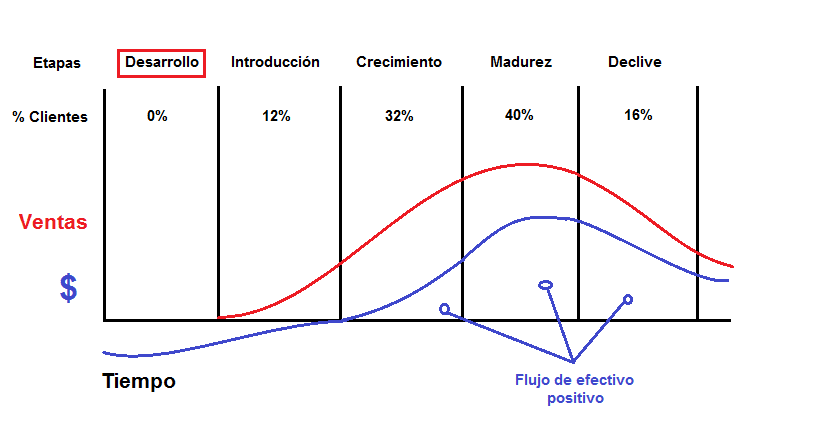
The life cycle of a product is defined as the set of different stages that a product goes through on the market. The constant evolution and development of new technologies, fashions, eras, and even legislation determine the useful and limited life of the products that companies offer. This means that the cash flows, investments destined to production, marketing, and profit margins, are different at all times. Knowing when a product is in itself is useful for any type of investment, and does not lead to surprises.
We are going to see what each stage is composed of and characterizes. Then, we will evaluate what type of product it is depending on the types of cycles they may have, since not all develop the same. Finally, what possibilities exist in the last stages of something that already exhausts the interest.
Life cycle of a product

The definition of the life cycle of a product takes its analogy in the life cycle of a living being. Since it is gestated, born, has its expansion, develops strongly and reaches maturity to finally continue with its decline. Not all products will have the same development, neither in sales nor temporarily, so each one will do it in their own way. Everything will depend on the strategies that companies make and the acceptance that the market dictates.
Development stage, crystallization
Many times people don't know what they want until you show it to them. Steve Jobs.

The development stage is the most daring and risky of all. In it, the idea and development of a product that does not yet exist on the market is born. The bet to assume this risk is centered on the fact that there is a latent demand not satisfied that has not yet materialized.

In this phase, there is no type of economic benefit, and financing is usually obtained by rounds, angel investors, with own funds or credits, etc. Depending on whether it is a company or a private individual, the obstacles will be different. In addition, the possibilities that the product does not "set" on the market exist, and it is not an easy decision to allocate money to something that has not yet worked.
The most interesting part of this stage is that there are no competitors nor third parties that are developing the same product. And usually the market tends to focus on new things, so being the first to offer something interesting can have a double prize.
Introduction, incorporation stage
A good marketing plan is developed to be able to launch the product with the maximum possible guarantees to open a gap in the market. The economic part that has been invested is high, and the feeling of uncertainty and risk is very high. The offer is very high, however the demand is not, still nascent. At this stage almost no one knows the new product, except for consumers who want to be trendy. A study to find out how the market reacts, positioning itself and making decisions in case strategies have to be redirected are key.

The characteristic of this stage is that not only consumers, but also arouses the interest of other companies that are closely watching the incorporation of the product to the market. The Boston Consulting Group describes these introductions as "questions.", by having sales potential although they are not yet shown. It is a premature moment to know if it will be a success or not.
Stage of growth, expansion
Advertising continues to be intense, and new companies begin to appear on the market. Consumers who know the product and buy it is increasing. Sales are beginning to have sufficient levels for profits to enter and increase. The average cost of the product destined for each client tends to be average, especially since production costs have decreased compared to the beginning.

At this point, the new competitors will try to position their products before advanced consumers. For this, working on reinforcing the positioning to continue differentiating itself is crucial.
Stage of maturity, consolidation
We enter the average consumers, that is, the majority of consumers who in the effervescence end up encouraging the acquisition. The product has reached its full potential in sales and has stabilized. The production cost is low. There is a lot of publicity, especially offering a good price to face the other competitors who are already considerable in number.
The maturity stage lasts longer than the previous ones. Most of the good turnover of a company comes from here, having reached the bulk of the market. The objective is to prolong this stage as much as possible, and for this there are different engagement techniques, marketing, product customization, different sizes, colors, etc.
Decline stage, termination
The stage of decline usually marks an end. Depending on the product, it can be slow or fast. The level of sales progressively decreases, the cost of production is usually low, and although the profit margin per unit is good, it is decreasing due to its sales. Little profit is given to the product, and the consumer profile is often defined as lagging behind. The efforts are focused above all on offering a good service, and not losing more customers.
The number of competitors is decreasing, especially those who did not know how to keep up in the maturity stage. Usually, Having reached the decline phase, there are two options: eliminate the product or innovate to relaunch it.

Examples of relaunch
A good example of relaunches is found in the automotive industry. Many brands tend to baptize their new lines of a segment of their vehicles with the previous name. We can see it in Opel, Toyota, Seat ... All new cars change their design, performance, and incorporate improvements in comfort, technology, with launch prices similar to the previous ones. In this way, they manage to remain well positioned while maintaining a market share.
We could see another example in theaters. Since they were black and white and without sounds, they enjoyed a very long stage of maturity. Over time, they incorporated sounds, colors, etc. Finally, television and domestic technology caused them a gradual decline without pause, with hardly any customers. However, they adapted to innovation, and by relaunching with 3D cinemas, they once again attracted an audience that seemed to have forgotten about them.
Are the life cycles of products always the same?
No, as we have commented, each product is a world in itself. However, if we take a general average references, the life cycles of the products are currently shorter than before. This is because today's consumers have highly variable tastes that are constantly changing. This trend forces companies to innovation and competitiveness to continue to stay in the market.
On the other hand, the competition that exists is much greater. There are so many possibilities today that if a product is not improved, it quickly falls into the background to the wide range of improvements and brands that exist.
What forces the end of the cycle of a product?
- Technology has overtaken it and now more sophisticated products are offered and better. For example cassettes to listen to music. So popular since 1970 with a decline from the 90's and that in the early 2000s they were completely finished. After the advent of CDs, they had little to do. Ask any teenager today what they think about when the music ends, you have to "rewind" and wait a while. That said, there are products that cannot even be relaunched.
- Consumers are exhausted and saturated with the same. And it is that a novelty is good, and for a few years too. Its profits are exploited, and in the end that's it, it ends there. People like news, and in the end they will get tired and have to be relaunched or abandoned. A real example that I have seen is in a Japanese restaurant close to where I live. They offered their buffet-style dishes on rotating ribbons. Over the years, people got tired, and their clientele dropped so much that I thought they were going to close, they had been like this for a long time. After some works, they changed the decoration, the music, their uniforms, and now they served the food by letter but also buffet. A success, again they are always full again, and the food is almost the same.
Can you decide the best time to relaunch a product?

Some products are relaunched while going through their phase of decline. However, a good time to incorporate new features is just in the maturity stage. At this time the company is generating strong profits that can be used to alleviate the costs involved in launching a new one. In this way, once the development and introduction phase is over, the company would take a dominant position minimizing its risks financial At the same time, the possibilities of customer loyalty increase, due to their satisfaction and trust in the brand.
In case of repeating this behavior in the cycle, we would have a company with continuous growth. This would be the result of the perfect combination of utilization of the benefits and development of new products.
The life cycle of a product may seem obvious, simple. It is quite possible that precisely for this reason sometimes it ends up being ignored. But it is right there, remembering that in the end everything is cyclical, where we can find good moments to guarantee the viability of the business.